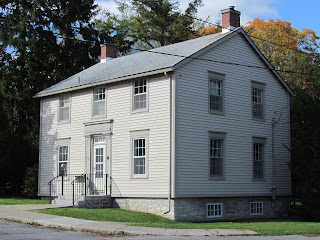 Friend and faithful AR reader Larry commented on the use of green in yesterday's post...ah, yes. Colour, when we had it. Today, November 13, our world is already smothered in snow - bright, crisp, beautifully lit by a conciliatory sun - but snow.
Friend and faithful AR reader Larry commented on the use of green in yesterday's post...ah, yes. Colour, when we had it. Today, November 13, our world is already smothered in snow - bright, crisp, beautifully lit by a conciliatory sun - but snow.Suddenly the earth is dormant, the heat usurped from the sun.
 Which is why looking backwards (not so very far) to a wander around Portsmouth Village heritage district with fellow old building nut Jane is such a delight.
Which is why looking backwards (not so very far) to a wander around Portsmouth Village heritage district with fellow old building nut Jane is such a delight.The buildings, the history, the topography sure. But the last of the fall colours in a clear fall light! Admittedly, it was a bit grudging early on, but burst forth enthusiastically in time for a waterside lunch at The Juniper, a short walk away.
 The Portsmouth streetscape is so typically c19, front steps parked right at the pavement. I don't know if a bit of garden might have been shaved off to widen the too-busy street at one time. Sadly, for all their charm, individually or collectively, homes along King Street West must be just too noisy and dusty and, well, public, with the relentless traffic.
The Portsmouth streetscape is so typically c19, front steps parked right at the pavement. I don't know if a bit of garden might have been shaved off to widen the too-busy street at one time. Sadly, for all their charm, individually or collectively, homes along King Street West must be just too noisy and dusty and, well, public, with the relentless traffic.One charming (though likely frustrating to locals) feature in Portsmouth is the English village trick of trades vans parking two wheels up on the sidewalk to stay out of the traffic, effectively blocking both the path and the street. That feature, and the one-way system designed to calm some of the traffic, makes Portsmouth Village an ideal spot - for walking.
 |
| stone corbels, parapet chimneys, eaves |
So much limestone to love. Jane's architect's eye spots things that get right past me, enthralled in my general wonder at the streetscape: unsympathetic chimneys, dormers, later expansions. But lovely with a touch of yellow.
 |
| lovely, with a past. Tall casements and a verandah? |
The village pump called out, but not too loudly. Coffee was the order of the day, and needs must. A national coffee chain, not especially sympathetically designed, was welcome, nonetheless.
Timber-frame decorated Portsmouth Tavern started life as Beaupre's (or Beaup's) across from the harbour and the penitentiary, in the 1860s. Bet this old place could tell some stories.
 |
| and just because, a gold car and an orange tree |
 |
| funny how weedy ivy and sumac redeem themselves in fall |
 |
| industrial buildings at the shoreline |
 Tannery Cottage, with its bright orange door and window frames, doubtless belonged to the Maxwell Strange tannery (from 1855) at the foot of Mowat Avenue. Its loss by fire predated the takeover of the waterfront by high-rise apartments.
Tannery Cottage, with its bright orange door and window frames, doubtless belonged to the Maxwell Strange tannery (from 1855) at the foot of Mowat Avenue. Its loss by fire predated the takeover of the waterfront by high-rise apartments. |
| Delightful mid-century modern next door |
This splendid red brick dates from 1818, and, as I explained in a long-ago post (link here) is the Gardiner house, which once stood at the water's edge, before some land reclamation took place.
It's now (if you'd care to look, here's Streetview pointing the way) sitting back of the historic town hall in Aberdeen Park, a good distance from the Portsmouth Yacht harbour across a do-not enter kind of parking lot.
Seen in profile, these houses are strikingly familiar. The red brick above has been researched and restored to give us confidence we're looking at an early c19 Georgian house.
The neat white double house at 140/42 just around the corner on Yonge Street is a relative. It's a double house, of 4 bays, but it doesn't take much imagination to see a former self. It's an old house, the limestone block foundation and giant tree give hints. But there are modern reproductions, which makes 'is it or innit?' a great game for a walk like this.
No guessing here. This beautifully kept New England-y Georgian with tight eaves and a stunning door surround is the John and Mary Pugh house, on Baiden Street, built 1860. Designation plaque says so.
Lovely Aberdeen Park (thank you community gardeners) and the village map which kept us scratching our heads for a while. No turning this baby upside down to get oriented.
In my first post about Portsmouth Village, almost 10 years ago, I mentioned Jennifer McKendry, Kingston historian, photographer and writer.
I'll close off this return visit with the suggestion that any ramble around this charming and historic place can only be improved by her wonderfully researched Portsmouth Village, Kingston: An Illustrated History.
At the time of publication of the revised second edition, 2010, it would appear that she lived in the Pugh house, 1 Baiden Street. Couldn't think of a better owner.











